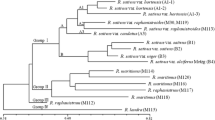Summary
Sporting is a well known phenomenon in chrysanthemum and a process by which new cultivars may arise vegetatively from the parental cultivar. A group of cultivars formed this way is called a family of cultivars. Mutations or cell layer rearrangements may be involved. In chrysanthemum there are three different cell layers that form different parts of the plant. Since the species is chimeric these cell layers may be genetically different. Differences at the DNA level among cultivars within one family and among the layers of one cultivar were studied by a PCR-based technique named RAPD analysis. Polymorphisms between cultivars as well as between different cell layers have been observed.
Similar content being viewed by others
References
Broertjes, C. & A.M. van Harten, 1978. Application of mutation breeding methods in the improvement of vegetatively propagated crops. Elsevier, Amsterdam, pp. 162–175.
Bush, S.R., E.D. Earle & R.W. Langhans, 1976. Plantlets from petal segments, petal epidermis, and shoot tips of the periclinal chimera, Chrysanthemum morifolium ‘Indianapolis’. Am. J. Bot. 63: 729–737.
Demeke, T., L.M. Kawchuk & D.R. Lynch, 1993. Identification of potato cultivars and clonal variants by Random Amplified Polymorphic DNA Analysis. Am. Potato J. 70: 561–570.
Dowrick, G.J., 1953. The chromosomes of Chrysanthemum II: garden varieties. Heredity 7: 59–72.
Dowrick, G.J. & A. El-Bayoumi, 1966. The origin of new forms of the garden Chrysanthemum. Euphytica 15: 32–38.
Erlich, H.A., D. Gelfand & J.J. Sninsky, 1991. Recent advances in the polymerase chain reaction. Science 252: 1643–1651.
Hu, J. & C.F. Quiros, 1991. Identification of broccoli and cauliflower cultivars with RAPD markers. Plant Cell Rep. 10: 505–511.
Khalid, N., M.R. Davey & J.B. Power, 1989. An assessment of somaclonal variation in Chrysanthemum morifolium: the generation of plants of potential commercial value. Sci. Hort-Amsterdam 38: 287–294.
Langton, F.A., 1980. Chimerical structure and carotenoid inheritance in Chrysanthemum morifolium (Ramat.). Euphytica 29: 807–812.
Lee, M. & R.L. Phillips, 1988. The chromosmal basis of somaclonal variation. Ann. Rev. Plant Physiol. 39: 413–437.
Malaure, R.S., G. Barclay, J.B. Power & M.R. Davey, 1991. The production of novel plants from florets of Chrysanthemum-Morifolium using tissue culture. 1. Shoot regeneration from ray florets and somaclonal variation exhibited by the regenerated plants. J. Plant Physiol. 139: 8–13.
Malaure, R.S., G. Barclay, J.B. Power & M.R. Davey, 1991. The production of novel plants from florets of Chrysanthemum-Morifolium using tissue culture. 2. Securing natural mutations (sports). J. Plant Physiol. 139: 14–18.
Saiki, R.K., D.H. Gelfand, S. Stoffel, S.J. Schare, R. Higuchi, G.T. Horn, K.B. Mullis & H.A. Erlich, 1988. Primer-directed enzymatic amplification of DNA with a thermostable DNA polymerase. Nature 239: 487–497.
Sampson, D.R., G.W.R. Walker, A.W.S. Hunter & M. Bragdo, 1985. Investigations on the sporting process in greenhouse chrysanthemums. Can. J. Plant Sci. 38: 346–356.
Stewart, R.N. & H. Dermen, 1970. Somatic genetic analysis of the apical layers of chimeral sports in Chrysanthemum by experimental production of adventitious shoots. Am. J. Bot. 57: 1061–1071.
Watanabe, K., 1977. The control of diploidlike meiosis in polyploid taxa of Chrysanthemum (Compositae). Jap. J. Genet. 52: 125–131.
Weising, K., H. Nybom, K. Wolff & W. Meyer, 1995. DNA finger-printing in plants and fungi. CRC Press, Boca Raton, Florida, pp. 1–322.
Wilde, J., R. Waugh & W. Powell, 1992. Genetic fingerprinting of Theobroma clones using randomly amplified polymorphic DNA markers. Theor. Appl. Genet. 83: 871–877.
Williams, J.G.K., M.K. Hanafey, J.A. Rafalsky & S.V. Tingey, 1993. Genetic analysis using random amplified polymorphic DNA markers. Meth. Enzymol. 218: 704–740.
Williams, J.G.K., A.R. Kubelik, K.J. Livak, J.A. Rafalsky & S.V. Tingev, 1990. DNA polymorphisms amplified by arbitrary primers are useful as genetic markers. Nucl. Acids Res. 18: 6531–6535.
Wolff, K. & J. Peters-Van Rijn, 1993. Rapid detection of genetic variability in chrysanthemum (Dendranthema grandiflora Tzvelev) using random primers. Heredity 71: 335–341.
Wolff, K., E. Zietkiewicz & H. Hofstra, 1995. Identification of chrysanthemum cultivars and stability of DNA fingerprint patterns. Theor. Appl. Genet. 91: 439–447.
Wolff, K., J. Peters-Van Rijn & B. Eijsma. Segregation and mapping of RFLP and RAPD markers in hexaploid chrysanthemum. In prep.
Author information
Authors and Affiliations
Rights and permissions
About this article
Cite this article
Wolff, K. RAPD analysis of sporting and chimerism in chrysanthemum. Euphytica 89, 159–164 (1996). https://doi.org/10.1007/BF00034601
Received:
Accepted:
Issue Date:
DOI: https://doi.org/10.1007/BF00034601



